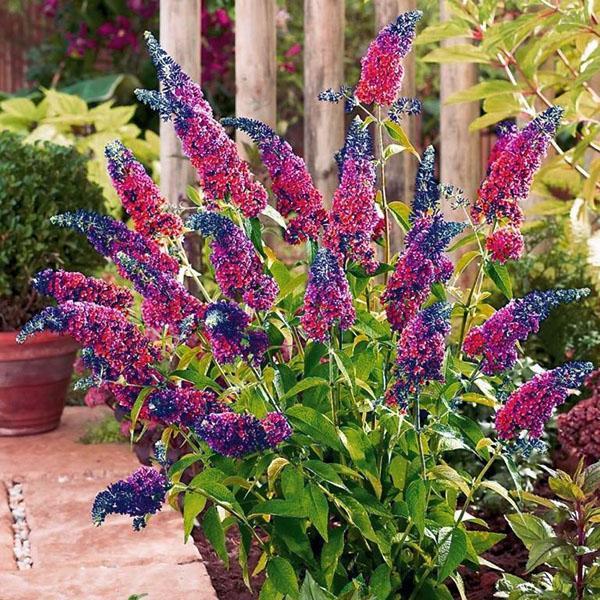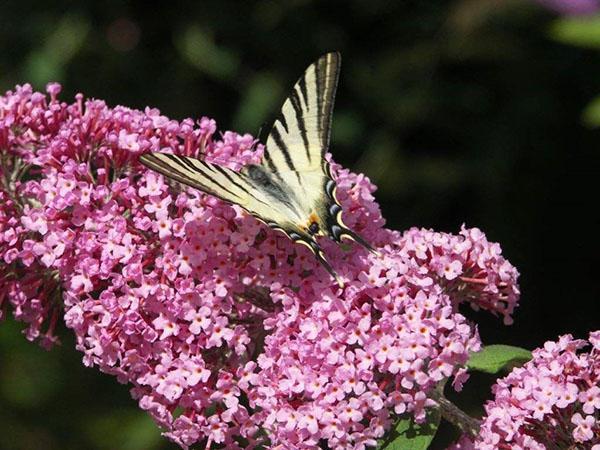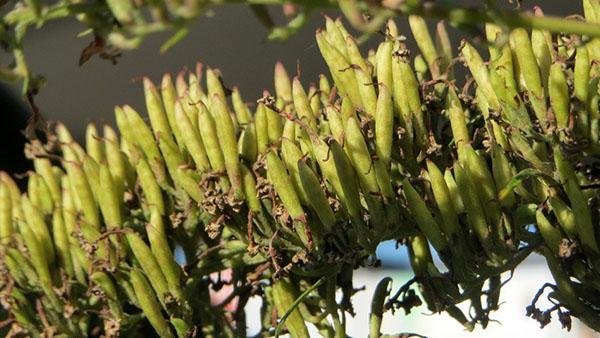Amazing Budlei Varieties and Types in Your Garden
 All types of budlei that are found in nature are the most favorite plants of most gardeners. And this is not surprising, because the shrub blooms very beautifully for a long time, and also has a delicious aroma. When the buds begin to bloom, thanks to the sweet smell, various insects gather around them, including butterflies. The description of the budley and the photo of the varieties can be viewed below in the article.
All types of budlei that are found in nature are the most favorite plants of most gardeners. And this is not surprising, because the shrub blooms very beautifully for a long time, and also has a delicious aroma. When the buds begin to bloom, thanks to the sweet smell, various insects gather around them, including butterflies. The description of the budley and the photo of the varieties can be viewed below in the article.
Plant feature

For American varieties, a spherical inflorescence is characteristic, and for Asian varieties, an oval one. They are at a very small distance from each other. The size of the buds is small. In loose form, they beckon with their honey sweet aroma, and can have many shades.
Most often, gardeners grow purple budleys. There are also lovers of red, orange, yellow and rose bushes.
The following plant varieties exist in nature:
- David;
- Witch's budley;
- Wilson;
- wake up Beautiful;
- White-flowered;
- Alternate-leaved;
- Snowy budley;
- Japanese;
- budley Spherical.
Plants can be wrapped in hay or straw for the winter, but the layer of dry grass should be thick.
Oddly enough, white plants are extremely rare. Basically, they have dots of various shades on a white background.
The flowering period begins in the second half of summer and lasts until the end of autumn. In our country, data shrubs can be found not so often and it will mainly be a variety of David. It gained its popularity due to its frost resistance.
 When flowering is over, bolls appear on the branches, in which the seeds are located. One of the characteristic features of the buddlea is that fruits, loose and unbuddled buds can be simultaneously on one inflorescence.
When flowering is over, bolls appear on the branches, in which the seeds are located. One of the characteristic features of the buddlea is that fruits, loose and unbuddled buds can be simultaneously on one inflorescence.
In care, this plant is not very capricious. The bush tolerates winter frosts well. However, if there is no snow, and the temperature drops below 20 degrees, then the ground part of the plant may freeze. But do not worry, if this happened, then waking up, due to the powerful root system, will release new shoots, and again will delight you with its lush long flowering.
To preserve the plant even in severe cold weather, it must be earthed up, or wrapped with fallen leaves from trees.
The main types of budley
 One of the most common varieties is Wilson's budley. The main distinguishing feature of this type of plant is its branches, which have the shape of a curved arc. The bush itself is quite tall. Inflorescences are deep pink or lilac. Their size can be up to 75 centimeters.
One of the most common varieties is Wilson's budley. The main distinguishing feature of this type of plant is its branches, which have the shape of a curved arc. The bush itself is quite tall. Inflorescences are deep pink or lilac. Their size can be up to 75 centimeters.
 No less beautiful shrub is the Snezhnaya buddleya. Plant height can reach three meters. The twigs, as well as the leaves and inflorescences, are slightly lowered down. In appearance it seems that the bush is hard from the piled snow drifts. Flowers are predominantly purple and lilac shades, located at the tips of the shoots. Their size reaches only 15 centimeters. This variety steadfastly resists all sorts of diseases, is unpretentious in care, but is afraid of severe frosts. Therefore, for the winter, the shrub is covered with straw, branches or leaves.
No less beautiful shrub is the Snezhnaya buddleya. Plant height can reach three meters. The twigs, as well as the leaves and inflorescences, are slightly lowered down. In appearance it seems that the bush is hard from the piled snow drifts. Flowers are predominantly purple and lilac shades, located at the tips of the shoots. Their size reaches only 15 centimeters. This variety steadfastly resists all sorts of diseases, is unpretentious in care, but is afraid of severe frosts. Therefore, for the winter, the shrub is covered with straw, branches or leaves.
 The peculiarity of Japanese budley is that it is a fast-growing plant. The height of the bush can reach three meters. Shoots consist of four edges, which forms a spreading crown. The leaves are slightly pointed, rather wide. Their length reaches 12 centimeters.
The peculiarity of Japanese budley is that it is a fast-growing plant. The height of the bush can reach three meters. Shoots consist of four edges, which forms a spreading crown. The leaves are slightly pointed, rather wide. Their length reaches 12 centimeters.
The flowers are lavender and have a pleasant honey aroma. They grow about 20 cm. This variety differs from other species by its rapid growth, but it is considered not so decorative.
 The spherical budlea has spreading shoots. This variety is an evergreen plant. You can meet him in the western regions of Chile and Argentina. The leaves are smooth to the touch on the outside, and the inside is empty. The length of the plates reaches 15 cm. The shrub grows about six meters in height. Flowering time is May. The buds are located at the ends of the branches, are orange or bright yellow. When loose, the flowers take on a spherical shape. The fruits ripen in autumn, in September. This variety does not tolerate cold and frost, therefore it is grown only in the southern regions.
The spherical budlea has spreading shoots. This variety is an evergreen plant. You can meet him in the western regions of Chile and Argentina. The leaves are smooth to the touch on the outside, and the inside is empty. The length of the plates reaches 15 cm. The shrub grows about six meters in height. Flowering time is May. The buds are located at the ends of the branches, are orange or bright yellow. When loose, the flowers take on a spherical shape. The fruits ripen in autumn, in September. This variety does not tolerate cold and frost, therefore it is grown only in the southern regions.
 The Budleya David opera is also a fast growing species. Flowers purple-purple tones, located at the ends of the shoots and slightly lowered down.
The Budleya David opera is also a fast growing species. Flowers purple-purple tones, located at the ends of the shoots and slightly lowered down.
 Budleya Sangold, or Weyer, has a free form, arched branches. The shrub can be up to 2 meters high. The leaves are green, narrow. The buds are bright orange in color. The flowering period is from June to October.
Budleya Sangold, or Weyer, has a free form, arched branches. The shrub can be up to 2 meters high. The leaves are green, narrow. The buds are bright orange in color. The flowering period is from June to October.
Description of budleya of the next-leaf and David
 The homeland of the alternate-leaved budley is the lands of northwestern China. Heat-loving plant, prefers sun and dry air. However, despite the love for high temperatures, this variety is one of the most frost-resistant.
The homeland of the alternate-leaved budley is the lands of northwestern China. Heat-loving plant, prefers sun and dry air. However, despite the love for high temperatures, this variety is one of the most frost-resistant.
This variety has several varieties:
- Budleya of David Arkin Bush is more suitable than anyone else for creating bouquets. The inflorescences have a volumetric shape and a blue-violet hue. The culture is very afraid of cold weather, therefore it needs shelter for the winter.

- Budleya David Black Knight has very beautiful flowers of deep purple color, inside them there are small orange specks. It grows mainly in the south.

- Budleya David Empire Blue is characterized by blue-violet flowers. It is a frost-resistant species. The plant tolerates difficult weather conditions and rarely gets sick.

- Budleya David White Profusion has a rounded bush shape. Inflorescences are predominantly white, cone-shaped.

It is a tall plant. The crown is spreading, the branches are arched with a smooth bark. The leaves are rather dull, dark green in color. The plates are oval with a pointed apex. On the inside, there are hairs on the leaves, as a result of which they acquire a gray tint.
Inflorescences are rather small, grow in a bunch. This variety blooms profusely for 25 days.
The main difference between the budleia is that the buds grow on the shoots left over from the last year. Therefore, in case of severe cold weather, the plant can bloom very weakly.
Budleya David has an average height of two to three meters. The shape of the bush is spreading. Shoots are slightly lowered down. The root system is superficial. Flowering begins at the age of three. To achieve constant bud formation, all faded inflorescences must be removed in time.
The flowers of this variety are small. Each of them is divided into four parts. It is their structure that resembles the well-known lilac. The shape is tubular. Shades can be different. The buds are often white or pastel shades. There are also bright orange, pink and crimson tones. Flowering time begins in July and lasts until the end of autumn. This type of shrub is very popular. Often such a plant can be found in garden plots, in parks.
Plant care
 Budleya requires certain rules of care.As for watering, it should be done only in dry, hot weather, the shrub does not tolerate strong waterlogging of the soil. Use settled water at room temperature, at the rate of 10 liters per bush. Make a special groove around the bush and water it into it.
Budleya requires certain rules of care.As for watering, it should be done only in dry, hot weather, the shrub does not tolerate strong waterlogging of the soil. Use settled water at room temperature, at the rate of 10 liters per bush. Make a special groove around the bush and water it into it.
 The plant needs periodic feeding. Apply 2-3 times for the season phosphorus and potassiumnecessary for long and lush flowering. Liquid humus and compost will also work.
The plant needs periodic feeding. Apply 2-3 times for the season phosphorus and potassiumnecessary for long and lush flowering. Liquid humus and compost will also work.
The shrub prefers loose soil. Just do not get carried away with deep loosening, so as not to damage the superficial root system.
 Pruning is an important part of grooming and needs to be done on time. Prune the stems so that they have the strength to release new shoots. Also, remove faded buds.
Pruning is an important part of grooming and needs to be done on time. Prune the stems so that they have the strength to release new shoots. Also, remove faded buds.
As for diseases and pests, whiteflies and spider mites. These pests love hot and dry weather, and it is in such conditions that this shrub grows. To get rid of insects, create the right moisture. If it doesn't work, then just cut off the affected areas and treat them with special insecticides.
 In September-October, you can start collecting seeds, since by this time they will have time to fully ripen. However, they will need to be properly prepared before planting. This process is quite laborious, and it will not give a 100% guarantee that they will rise. Therefore, experienced gardeners often buy ready-made seeds.
In September-October, you can start collecting seeds, since by this time they will have time to fully ripen. However, they will need to be properly prepared before planting. This process is quite laborious, and it will not give a 100% guarantee that they will rise. Therefore, experienced gardeners often buy ready-made seeds.
To prepare a shrub for wintering, you must adhere to simple rules. It is necessary to huddle the plant with earth to a height reaching the third bud on the stem. It is worth starting this process when the leaf plates acquire a brown tint. Next, prune the branches, and then cover the bush with spruce branches. Install a wooden box on top of such a structure and wrap it with roofing felt. Press down on top with bricks or stones so that strong winds and snows cannot destroy it.
As you can see, buddleya has many varieties, which is why it attracts the attention of experienced gardeners. With the right choice of a plant, you can radically transform the territory, thus emphasizing the individuality of the owner.